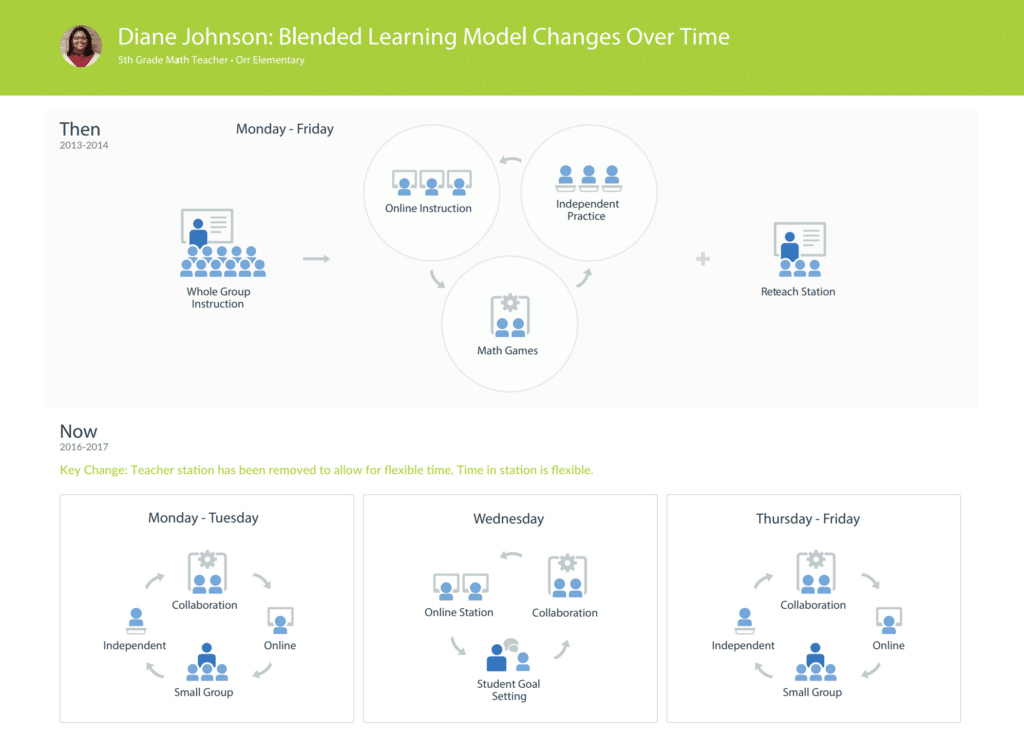“Everyone was doing the same thing.” In retrospect, 5th-grade teacher Diane Johnson laments the lack of diversity of students’ experiences in her first blended-learning classroom at Orr Elementary School. As part of the first cohort of blended educators in the District of Columbia Public Schools in 2013, Johnson had established a Station Rotation routine in her math and science classroom. She started off her class with a whole-group lesson, then moved students through three different 15-minute stations—one station was the adaptive assessment and instructional tool i-Ready, another was math games, and a third was independent work based on the lesson. Meanwhile, Johnson pulled out small groups of students as needed to hash out the lesson for students who needed a “reteach” or extra help. Every student went to every station every day.
Then while serving as a 2015 Education Innovation Fellow visiting other blended schools, Johnson’s thinking as a teacher shifted. She noticed that those schools integrated an increased measure of differentiation into their models, and she questioned the efficacy of the whole-class instructional model she had always used. “In whole-group, I felt like I was teaching to the middle and realizing that students who were clearly [ready] for next-level stuff were bored, and the students who weren’t accessing the concepts and understanding, I was always pulling them into my re-teach station.” She took this idea back to her classroom and adapted her model to include a teacher station with small groups that were organized by level.
From there, school visits to other blended-learning schools continued to motivate her to adapt the model.
On a visit to City Neighbors Charter School in Baltimore, Johnson was inspired by the fact that the teacher didn’t need to manage and direct the students constantly. “The students were so independent. They knew what they were doing and why they were doing it,” Johnson observed. “I wanted my students to have this mentality, to be able to speak to what they were doing, why they were doing it, and be independent learners.” At other schools, Johnson saw that flexibility with seating and space leant students a new level of trust and a chance to take ownership of their learning process. “Before [the fellowship], I always had the kids face away from me so I could see everyone’s screen,” Johnson recalled. “But I decided to have the mindset of ‘Give me a reason not to trust you.’”
Back in her classroom, Johnson made a dramatic shift: she transitioned her classroom from a Station Rotation to a Flex model. In that model, Johnson began to peel away the visible markers of strict classroom structure. She let her students choose where they sat—on the floor, on pillows, on a couch, or at tables. It was an adjustment for her as a teacher to let go of organized space. “I thought it would be chaotic and I would lose control of the space,” Johnson said. Because she could still monitor student progress online, however, she grew to feel more comfortable with students learning where they pleased. And to guide her students along their learning path, Johnson added weekly, one-on-one check-ins so that she could share data with students and help them to set their own learning goals for the next week.

After some time, though, Johnson realized that her students might benefit from some of the structures that she had eagerly cut out. “I was giving students a lot of freedom—to choose which program to go on, to let them set their own goals,” she said. “But some [of their goals] were so unrealistic… and I didn’t give a lot of guidance. I wanted the class to look like what I had seen [in other schools], but I was asking a lot of the students.” Johnson decided to rein the model back in. She spent the summer break tweaking and testing a revised approach. In her latest iteration, Johnson has reinstated labeled stations around the class so that students physically rotate and know exactly where to work. Within each station area, though, students still have multiple seating options. Johnson also uses a timer again to move students through three stations: peer collaboration, independent online practice, and small-group instruction with the teacher.
Today, Johnson believes that her students are benefiting from a return to the guidance provided by the Station Rotation, while at the same time retaining some ownership of learning goals, space, and activities of a Flex approach. This key shift means that even though all of Johnson’s students are still rotating through each station, they are doing so with personalized goals on their mind. Keeping an eye on individual students’ needs, Johnson intends to continue evolving the model over time. “I want to push toward a classroom where we don’t necessarily have a timer,” she said. “My vision is that the stations are there, but they are moving when they know they are ready to move, not when I say they are ready to move.”



